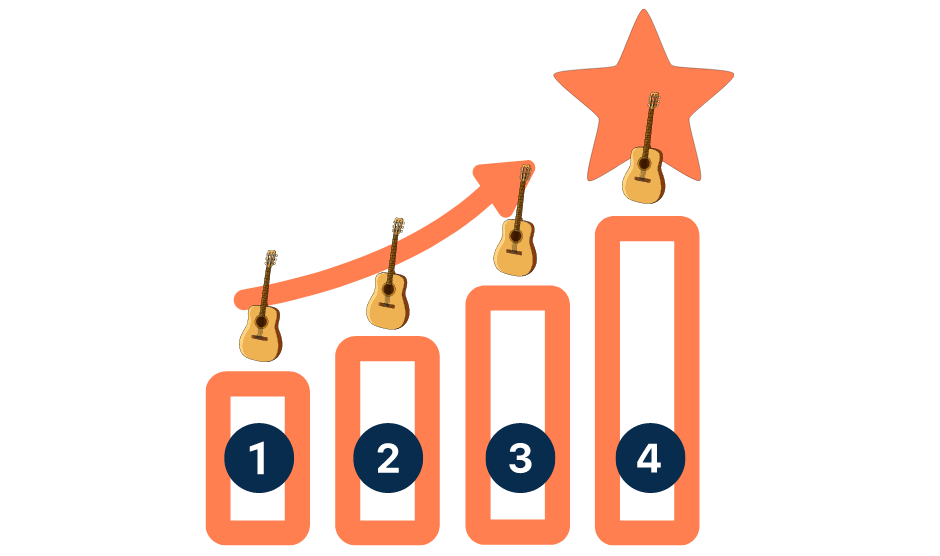
Why Focus on Guitar Chords First?
Before diving into the steps, it’s important to understand why chords are the foundation of guitar playing. Chords are groups of notes played together, forming the harmonic backbone of most songs. By learning basic guitar chords, you unlock the ability to play thousands of songs across genres. Whether you want to play pop, rock, folk, or classical, chords are essential.
1. Get Comfortable Holding the Guitar
The journey to learning guitar chords fast starts with the basics: how you hold your instrument. Proper posture and hand positioning make a huge difference in your ability to play clean chords and avoid injury.
Tips for Proper Guitar Posture:
- Sit upright on a chair without armrests.
- Rest the guitar body on your right thigh (for right-handed players).
- Keep your back straight and shoulders relaxed.
- Hold the neck with your left hand, keeping your thumb behind the neck for support.
- Position your right arm over the guitar body, ready to strum.
A comfortable, relaxed position helps you play longer and with less fatigue. Take a few moments before each practice session to check your posture.
2. Tune Your Guitar
A well-tuned guitar is essential for learning chords. Playing on an out-of-tune instrument can be discouraging and train your ear incorrectly.
How to Tune Your Guitar:
- Use a digital tuner, tuning app, or clip-on tuner.
- Tune each string to standard tuning: E (6th), A (5th), D (4th), G (3rd), B (2nd), e (1st).
- Pluck each string individually and adjust the tuning pegs until the tuner shows the correct note.
Pro Tip:
Tune your guitar before every practice session. This ensures you develop a good ear for pitch and your chords sound pleasant.
3. Learn the String Names and Numbers
Understanding the layout of your guitar is crucial for reading chord diagrams and instructions.
Standard String Names and Numbers:
- 6th string: E (thickest string, closest to you)
- 5th string: A
- 4th string: D
- 3rd string: G
- 2nd string: B
- 1st string: e (thinnest string, closest to the floor)
Why This Matters:
When learning new chords, instructions often refer to string numbers and names. Knowing them helps you follow lessons and chord charts with ease.
4. Start with Basic Open Chords
Open chords are the foundation for most beginner guitarists. These chords use open strings (strings played without pressing down) and are easier to play than barre chords.
Essential Open Chords for Beginners:
- C Major (C)
- G Major (G)
- D Major (D)
- E Minor (Em)
- A Minor (Am)
- E Major (E)
- A Major (A)
How to Practice:
- Learn one chord at a time.
- Place your fingers as shown in chord diagrams.
- Strum all the strings required for the chord.
- Listen for clear, ringing notes. If a string sounds muted, adjust your finger position.
Example: C Major Chord
- Index finger: 1st fret, 2nd string (B)
- Middle finger: 2nd fret, 4th string (D)
- Ring finger: 3rd fret, 5th string (A)
Practice Tip:
Spend a few minutes each day on each chord. Don’t rush—accuracy and muscle memory are more important than speed at this stage.
5. Use Chord Diagrams and Visual Aids
Chord diagrams are visual representations of the guitar fretboard and finger positions. Using diagrams helps you quickly understand where to place your fingers.
How to Read a Chord Diagram:
- Vertical lines represent strings (leftmost is 6th string, rightmost is 1st string).
- Horizontal lines represent frets.
- Dots show where to place your fingers.
- Numbers may indicate which finger to use (1 = index, 2 = middle, 3 = ring, 4 = pinky).

Why Visual Aids Help:
- They make learning less confusing.
- They reinforce memory through visual association.
- You can print diagrams or use apps for quick reference.
Pro Tip:
Keep a chord chart handy during practice. Over time, you’ll memorize the shapes and no longer need to look them up.
6. Practice Finger Placement and Pressure
Proper finger placement is key to producing clean, buzz-free chords. Many beginners struggle with muted or buzzing strings, but this can be fixed with a few adjustments.
Tips for Clean Chords:
- Use the very tips of your fingers to press down on the strings.
- Place your fingers close to the fret wire (but not on top of it).
- Keep your fingers curved and your knuckles arched.
- Apply enough pressure to get a clear sound, but don’t press too hard.
Avoid:
- Letting your fingers touch adjacent strings (causing muting).
- Flattening your fingers instead of arching them.
- Placing fingers too far from the fret, causing buzzing.
Exercise:
Play each string of the chord individually to check for clarity. Adjust your fingers as needed until all strings ring out cleanly.
7.Practice Chord Transitions
One of the biggest challenges for beginners is switching between chords smoothly. Fast, accurate chord changes are essential for playing songs.
How to Improve Chord Transitions:
- Pick two chords (e.g., G and C).
- Slowly switch between them, focusing on accuracy.
- Don’t worry about speed at first—aim for clean transitions.
- Gradually increase your speed as you become more comfortable.
- Use a metronome to practice switching chords in time.
Pro Tip:
Practice “air changes”—move your fingers to the next chord shape in the air before placing them down. This builds muscle memory for faster transitions.
8. Play Simple Songs with Basic Chords
Applying your new chord skills to real music is both motivating and educational. Many popular songs use just two or three chords.
Examples of Easy Songs:
- “Knockin’ on Heaven’s Door” (G, D, Am, C)
- “Horse with No Name” (Em, D6add9/F#)
- “Three Little Birds” (A, D, E)
How to Practice:
- Find songs that use the chords you’ve learned.
- Play along with recordings to develop timing.
- Start slowly and increase speed as you improve.
Why This Works:
Playing songs keeps practice fun and helps you develop rhythm, timing, and chord memory.
9. Practice Daily for Consistent Progress
Consistency is the secret to learning guitar chords fast. Short, focused practice sessions every day are more effective than occasional long sessions.
Daily Practice Routine:
- Warm up with finger exercises (5 minutes).
- Practice individual chords (10 minutes).
- Work on chord transitions (10 minutes).
- Play a simple song (5–10 minutes).
Tips for Effective Practice:
- Set a timer to stay focused.
- Practice at the same time each day to build a habit.
- Track your progress in a notebook or app.
Motivation Booster:
Celebrate small milestones, like mastering a new chord or playing a song all the way through.
10. Track Your Progress and Stay Motivated
Learning guitar is a journey, and tracking your progress keeps you motivated. Seeing improvement, no matter how small, encourages you to keep going.
How to Track Progress:
- Keep a practice journal. Note which chords you’ve learned and which songs you can play.
- Record yourself playing to hear your improvement over time.
- Set small, achievable goals (e.g., learn one new chord per week).
Staying Motivated:
- Play music you love.
- Join online guitar communities to share your progress.
- Reward yourself for reaching milestones.
Bonus Tips for Learning Guitar Chords Fast
- Stay relaxed: Tension in your hands or body slows you down and can cause pain.
- Use slow, deliberate movements: Accuracy is more important than speed in the beginning.
- Experiment with finger positions: Everyone’s hands are different—find what feels comfortable for you.
- Take breaks: Short breaks during practice prevent fatigue and keep you fresh.
- Stay patient: Progress may seem slow at first, but with consistent effort, you’ll improve steadily.
Conclusion
Learning guitar chords fast is achievable with the right mindset, consistent practice, and a step-by-step approach. By following these 10 essential steps—getting comfortable with your guitar, tuning, learning string names, mastering open chords, using diagrams, practicing finger placement, working on transitions, playing songs, practicing daily, and tracking your progress—you’ll build a strong foundation for your guitar journey.
Remember, every great guitarist started as a beginner. Stay patient, enjoy the process, and celebrate your progress. Soon, you’ll be strumming along to your favorite songs and impressing your friends with your new skills.